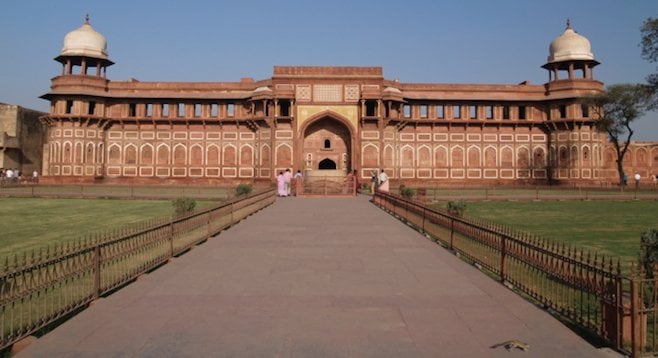 Facebook
Facebook
 X
X
 Instagram
Instagram
 TikTok
TikTok
 Youtube
Youtube

The stunning architectural beauty of the Taj Mahal, built entirely of white marble, is particularly evident at sunrise and sunset. At sunrise the changing light casts shadows, and at night it seems to glow – especially when there’s a full moon.
The Taj was built by the Mughal Emperor Shah Jahan in memory of his wife, Mumtaz Mahal, in Agra, India, and houses the grave of the beloved queen.
The entrance fee to the Taj has increased to $20, but it’s well worth it to visit this wonder of the world. You’ll find many guides who will point out (for a fee) the best spots for taking photographs. Ticket lines are longest at the west gate and shortest at the south gate.
After you’ve visited the Taj Mahal, take a 2.5-kilometer drive to the Red Fort of Agra, a UNESCO World Heritage Site. The fort was originally built with brick by Hindus; the Islamic Mughals later captured the fort and rebuilt it with red sandstone. Be sure to check out the Delhi Gate and the Lahore Gate when entering. Throughout the fort you’ll see the interesting mix of Hindu and Islamic architecture.
Most guide books recommend that you make a day trip from Delhi to Agra to see the Taj Mahal. The city itself is quite dirty and polluted, and there’s little else to warrant spending a night there. The Taj is closed on Fridays, so make sure to schedule your visit on a day to see both monuments.
You can also see the Taj Mahal for free by climbing onto a hotel rooftop in the Taj Ganj neighborhood, or go to a small Krishna temple by the Yamuna River where you can see the Taj or take a boat ride (100 rupees) to see it from the river. If you’re not a fan of crowds, have a guide take you across the Yamuna on a road bridge to Mehtab Bagh for another breathtaking view of the Taj at dawn.
After daytripping at the Taj and Red Fort, be sure to experience the famous Mughlai cooking in the many area restaurants before returning to Delhi.


The stunning architectural beauty of the Taj Mahal, built entirely of white marble, is particularly evident at sunrise and sunset. At sunrise the changing light casts shadows, and at night it seems to glow – especially when there’s a full moon.
The Taj was built by the Mughal Emperor Shah Jahan in memory of his wife, Mumtaz Mahal, in Agra, India, and houses the grave of the beloved queen.
The entrance fee to the Taj has increased to $20, but it’s well worth it to visit this wonder of the world. You’ll find many guides who will point out (for a fee) the best spots for taking photographs. Ticket lines are longest at the west gate and shortest at the south gate.
After you’ve visited the Taj Mahal, take a 2.5-kilometer drive to the Red Fort of Agra, a UNESCO World Heritage Site. The fort was originally built with brick by Hindus; the Islamic Mughals later captured the fort and rebuilt it with red sandstone. Be sure to check out the Delhi Gate and the Lahore Gate when entering. Throughout the fort you’ll see the interesting mix of Hindu and Islamic architecture.
Most guide books recommend that you make a day trip from Delhi to Agra to see the Taj Mahal. The city itself is quite dirty and polluted, and there’s little else to warrant spending a night there. The Taj is closed on Fridays, so make sure to schedule your visit on a day to see both monuments.
You can also see the Taj Mahal for free by climbing onto a hotel rooftop in the Taj Ganj neighborhood, or go to a small Krishna temple by the Yamuna River where you can see the Taj or take a boat ride (100 rupees) to see it from the river. If you’re not a fan of crowds, have a guide take you across the Yamuna on a road bridge to Mehtab Bagh for another breathtaking view of the Taj at dawn.
After daytripping at the Taj and Red Fort, be sure to experience the famous Mughlai cooking in the many area restaurants before returning to Delhi.
Comments